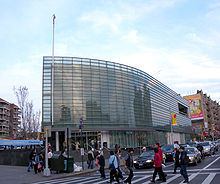Libraries

Flushing contained the first public library in Queens, founded in 1858. Today, Queens Public Library contains five libraries in Flushing.
The largest of the libraries is the Flushing branch, located at the intersection of Kissena Boulevard and Main Street in Flushing's central business district. It is the busiest branch of the Queens Public Library, the highest-circulation system in the United States. This library has an auditorium for public events. The current building, designed by Polshek Partnership Architects, is the third to be built on the site—the first was a Carnegie library, built through a gift of Andrew Carnegie.
The other branches are...
East Flushing – 196-36 Northern Boulevard McGoldrick – 155-06 Roosevelt Avenue Mitchell-Linden – 31-32 Union Street Queensboro Hill – 60-05 Main Street In addition, the Auburndale, Hillcrest, and Pomonok libraries carry Flushing addresses but are not located in Flushing proper.Health's population
As of 2018, preterm births and births to teenage mothers are less common in Flushing and Whitestone than in other places citywide. In Flushing and Whitestone, there were 63 preterm births per 1,000 live births (compared to 87 per 1,000 citywide), and 8 births to teenage mothers per 1,000 live births (compared to 19.3 per 1,000 citywide). Flushing and Whitestone have a higher than average population of residents who are uninsured. In 2018, this population of uninsured residents was estimated to be 14%, slightly higher than the citywide rate of 12%.
The concentration of fine particulate matter, the deadliest type of air pollutant, in Flushing and Whitestone is 0.0073 milligrams per cubic metre (7.3×10−9 oz/cu ft), less than the city average. Thirteen percent of Flushing and Whitestone residents are smokers, which is lower than the city average of 14% of residents being smokers. In Flushing and Whitestone, 13% of residents are obese, 8% are diabetic, and 22% have high blood pressure—compared to the citywide averages of 22%, 8%, and 23% respectively. In addition, 15% of children are obese, compared to the citywide average of 20%.
Ninety-five percent of residents eat some fruits and vegetables every day, which is higher than the city's average of 87%. In 2018, 71% of residents described their health as "good," "very good," or "excellent," lower than the city's average of 78%. For every supermarket in Flushing and Whitestone, there are 6 bodegas. The nearest major hospitals are NewYork–Presbyterian/Queens and Flushing Hospital Medical Center. NewYork–Presbyterian/Queens serves Flushing as well as surrounding communities with comprehensive medical care services. Numerous tertiary medical clinics also serve the residents of Flushing.